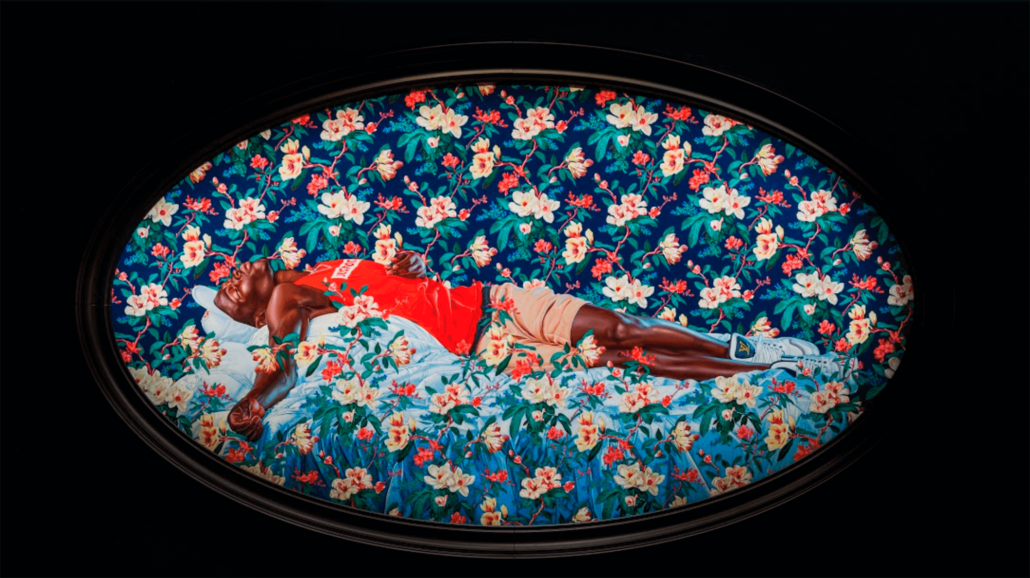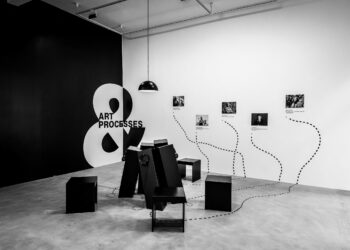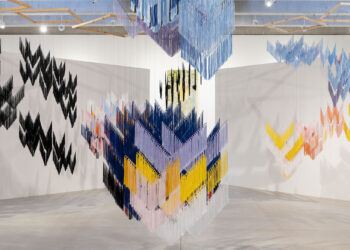The Fine Arts Museums of San Francisco (the “Museums”) are honoured to host the US premiere of Kehinde Wiley: An Archaeology of Silence, a monumental new body of work created against the backdrop of the COVID-19 pandemic, the murder of George Floyd, and the worldwide rise of the Black Lives Matter movement.

Installation of ‘Kehinde Wiley: An Archaeology of Silence’. Kehinde Wiley, Sleep, 2022. Oil on canvas, 177.7 x 274.2 cm. Framed: 180 x 302 x 10cm. ©️ 2022 Kehinde Wiley Courtesy of the artist and Templon, Paris – Brussels – New York. Photographer: Ugo Carmeni.
Expanding upon American artist Kehinde Wiley’s Down series from 2008, ‘An Archaeology of Silence’ meditates on the deaths of young Black people slain all over the world. These 26 works stand as elegies and monuments, underscoring the fraught terms in which Black bodies are rendered visible, especially when at the hands of state-sanctioned violence.
“As part of the Museums intentional focus on exhibiting the work of groundbreaking Black artists, it is an immense privilege to host ‘Kehinde Wiley: An Archaeology of Silence’ at the de Young museum,” stated Thomas P. Campbell, Director and CEO of the Fine Arts Museums of San Francisco. “Utilising the historical visual language of the dying hero, Wiley’s portraits of Black youths render visible previously obscured victims of state violence. In the Bay Area – a place that has resisted violence against Black bodies, as evidenced in the Black Power movement and the current Black Lives Matter movement – Wiley’s work has deep resonances. They ask each of us, how are we implicated? And how do we take action?”
The artist’s 2008 Down series featured a group of large-scale portraits of young Black men inspired by Hans Holbein the Younger’s The Dead Christ in the Tomb (1521–1522). Holbein’s painting triggered an ongoing investigation into the iconography of death and sacrifice in Western art that Wiley traced across religious, mythological, and historical subjects. ‘An Archaeology of Silence’ reconceptualises this research into paintings and sculptures that confront the legacies of colonialism through the visual language of the fallen figure.
The resulting paintings of Black bodies struck down, wounded, resting, or dead, all referencing historical paintings of heroes, martyrs, or saints, offer a haunting meditation on the violence against Black and Brown bodies through European art historical references.
“By inscribing Black bodies into known examples of Western painting and sculpture, Kehinde Wiley counters the historical erasure of people of colour from the dominant cultural narratives,” said Claudia Schmuckli, Curator in Charge of Contemporary Art and Programming at the Fine Arts Museums of San Francisco. “This new body of work forgoes the rhetorical tools of empire that have informed his portraiture thus far to shift the conversation toward a recognition of suffering and resilience that is both vulnerable and strong, elegiac and ecstatic, devastating and beautiful.”
‘Kehinde Wiley: An Archaeology of Silence’ contains some of the largest paintings and sculptures Wiley has created to date, as well as some of the smallest. The series uses scale to elevate the people depicted to heroic status, generally absent from the depictions of the recumbent or fallen figure in Western art (including those that Wiley’s works have been based on). It marks an important departure in the artist’s work which, with the notable exception of Down, has been primarily concerned with verticality and elevation, projecting Black youth into positions of power and grace by painting them into compositions inspired by canonical Western portraits such as Anthony van Dyck’s Charles I at the Hunt (1636) or Jacques-Louis David’s Napoleon Crossing the Alps (1801), among many others.
Created against the backdrop of the COVID-19 pandemic, Wiley had to forgo his usual practice of “street casting,” instead working with residents, staff, and friends of Black Rock, a residency program he established in 2019 in Dakar, Senegal, and where he spent most of his time during the international lockdown. With the rise of the Black Lives Matter movement, Wiley saw an opportunity to broaden the conversation beyond national concerns. The figures’ personal markers of Senegalese and West African culture, with regard to hair in particular, serve as a metaphor for the many places where systematically oppressed communities of Black and Brown people experiencing the same state violence around the world.
‘Kehinde Wiley: An Archaeology of Silence’ is part of the Museums’ Department of Contemporary Art and Programming. Presented in the de Young museum’s second-floor galleries, the exhibition centres contemporary conversations and explorations of the American identity, expanding on the narrative told in the adjacent galleries dedicated to the Museums’ historic American Art collection.
The exhibition is made possible by a $1 million grant from the Ford Foundation. In addition to providing exhibition support, this generous gift will enable the presentation of a series of public programs and interpretation by community members who work in the areas of restorative justice and human rights, to inform the visitors’ experience in the exhibition.
“Kehinde Wiley’s visionary art sends an affirming and profound message by filling the void of Black representation in history and shining a light on the Black experience of today. His art has the power to ignite innovative ideas about culture and justice, helping us reconsider how we see ourselves and the world around us,” said Ford Foundation President Darren Walker. “The Ford Foundation is proud to support the exhibition of this work and the reflections that it will share.”
‘Kehinde Wiley: An Archaeology of Silence’ will be on view form the 18th of March until the 15th of October, 2023, at the de Young museum in San Francisco. Claudia Schmuckli, Curator in Charge of Contemporary Art and Programming at the Fine Arts Museums of San Francisco, serves as curator for the presentation of the work at the de Young. For more information, please visit de Young.



